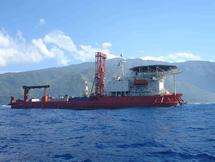Tahiti corals clue to 'dynamic' glaciers

(PhysOrg.com) -- Fossilised corals from tropical Tahiti show that the behaviour of ice sheets is much more volatile and dynamic than previously thought, a team led by Oxford University scientists has found.
Analysis of the corals suggests that ice sheets can change rapidly over just hundreds of years - events associated with sea level rises of several metres over the same period. It also shows that a natural warming mechanism thought to be responsible for ending ice ages does not fit the timing of the end of the penultimate ice age, around 137,000 years ago.
A report of the research appears online in this week’s Science.
‘It’s amazing just how rapidly these ‘melting’ - or ‘deglaciation’ - events occurred and how enormous the volumes of ice involved were,’ said Dr Alex Thomas, from the Department of Earth Sciences at Oxford University, lead author of the paper. ‘In the case of deglaciation after the penultimate ice age, before 137,000 years ago, we’re talking about ice sheets - that covered most of the USA and Canada and were up to five kilometres thick - simply vanishing.’
The tropical paradise of Tahiti is an ideal place to study the sea level rises associated with deglaciation. This is because not only is it home to different species of corals that like to live at different depths but it is sinking at a constant rate which can be adjusted for when dating these corals, and it is far enough away from the ice sheets not to be affected by displacement or gravitational effects.
‘Getting to these ancient fossilised corals without damaging the reef and local ocean life is far from easy,’ said Dr Thomas. ‘A robot submersible was sent to survey the ocean floor and placed a target which was used to guide down a drill from a shallow-draft drilling vessel with great precision and extract our cores. We only left a tiny hole behind that soon disappeared - something that was only possible because of the expertise of the Integrated Ocean Drilling Programme.’
The fossilised coral within the cores showing sea level changes was then dated using a uranium dating technique at which Oxford’s Department of Earth Sciences is a world-leader. The timing of these changes showed that a natural warming mechanism known as northern hemisphere summer insolation could not have caused the deglaciation that brought the penultimate ice age to an end.
Dr Thomas said: ‘People had assumed that because this natural warming mechanism matched the timing of deglaciation ending the last ice age (around 21,000 years ago) that it would be responsible for the one before that. What we have shown is that this was not the case. We are starting to understand that recent observations of changes in ice sheets have not prepared us for just how rapidly the covering of ice across the Earth can fluctuate and that, as yet, we have not identified all the natural phenomena which drive deglaciation.’
Provided by Oxford University (news : web)


















